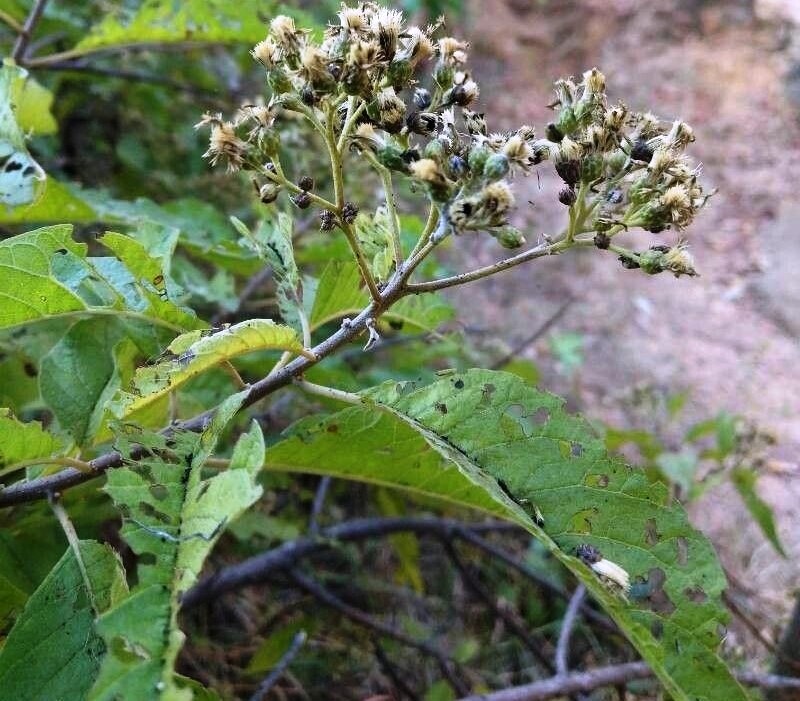Vernonia colorata

|
|
Vernonia colorata Common Names: Bitter Tree, Sweet Bitter Leaf, Ironweed Scientific
Classification Kingdom: Plantae Clade: Tracheophytes Clade: Angiosperms Clade: Eudicots Clade: Asterids Order: Asterales Family: Asteraceae Genus: Vernonia Species: V. colorata Binomial Name: Vernonia colorata (Willd.) Drake Synonyms: Vernonia senegalensis Less., Vernonia amygdalina sensu auct. (misapplied) Morphological Description Vernonia colorata, commonly known as Bitter Tree, is a perennial shrub or small
tree, typically 1–3 m tall, occasionally reaching 5 m. It is characterized by: · Stems: Woody at the base, erect, with greyish-brown bark · Leaves: Elliptic to lanceolate, 5–15 cm long, 2–6 cm wide,
rough-textured, dark green, with serrated margins · Flowers: Small, purple to white, 6–10 mm in diameter, in dense
terminal clusters, blooming from November to March · Fruit: Achenes, 2–3 mm long, with a bristly pappus for wind
dispersal Its bitter leaves
distinguish it from related species (Orwa et al., 2009). Distribution and Habitat Vernonia colorata is native to tropical Africa, occurring in countries such as
Nigeria, Ghana, Uganda, Cameroon, and Côte d’Ivoire. It thrives in: · Habitats: Forest edges, open woodlands, grasslands, and riverbanks · Climate: Tropical, with rainfall of 900–2,500 mm annually,
temperatures of 20–32°C · Soil Conditions: Well-drained loamy or sandy soils (pH
5.0–6.5) · Elevation: Sea level to 1,800 m It often grows in
disturbed areas, showcasing its adaptability (Toyang & Verpoorte, 2013). Ethnopharmacology Vernonia colorata, a member of the Asteraceae family, is a medicinal plant widely
used in African traditional medicine for its diverse healing properties. The
leaves, roots, and stem bark are commonly utilized in decoctions or infusions
to treat ailments such as malaria, fevers, intestinal parasites, diarrhea, skin
infections, and inflammatory conditions. The plant is known for its
antimalarial, antimicrobial, antioxidant, anti-inflammatory, and analgesic
effects. Phytochemical investigations have revealed the presence of flavonoids,
tannins, saponins, and alkaloids, which are associated with its pharmacological
activity. In addition to its medicinal applications, Vernonia colorata is
sometimes used as a bitter tonic to stimulate appetite and digestion. While its
traditional use is widespread, further pharmacological and clinical research is
necessary to substantiate its efficacy and establish safe usage guidelines. · Antimalarial: Leaf extracts inhibit Plasmodium
falciparum (IC₅₀ 10 µg/mL), used in Nigeria for malaria fevers (Gasquet et
al., 1985). · Anthelmintic: Vernolide shows efficacy against Schistosoma mansoni (ED₅₀ 5 µg/mL), used in Ghana for worms (Adu et
al., 2018). · Anti-inflammatory: Ethanol extracts reduce inflammation in
rats (55% at 200 mg/kg), used in Uganda for joint pain (Toyang et al., 2012). · Antimicrobial: Extracts inhibit S.
aureus (MIC 0.3 mg/mL), used in Côte d’Ivoire for infections (Gasquet et
al., 1985). · Gastrointestinal Treatment: Leaf decoctions treat dysentery in Togo,
with tannins aiding gut health (Yeap et al., 2010). · Skin Conditions: Leaf poultices heal wounds in Nigeria. ⚠ Toxicity Profile: No acute toxicity at traditional doses (LD₅₀
> 2,000 mg/kg in rats), but high doses of vernolide may cause cytotoxicity
(LC₅₀ 20 µg/mL in vitro). Overuse may lead to gastrointestinal upset; pregnant
women should avoid due to potential uterine stimulation (Toyang &
Verpoorte, 2013). Phytochemistry The plant’s therapeutic
properties stem from a rich phytochemical profile: · Sesquiterpene Lactones: Vernolide, hydroxyvernolide, with
antimalarial and anthelmintic effects · Flavonoids: Quercetin, luteolin, providing antioxidant and
anti-inflammatory benefits · Tannins: Astringent compounds aiding gastrointestinal health · Saponins: Contribute to antimicrobial properties · Phenolics: Support antioxidant and wound-healing actions Additional Uses · Ethnoveterinary: Leaves treat heartwater in goats in South
Africa (Yeap et al., 2010) · Nutritional: Young leaves consumed as a bitter vegetable in Ghana · Environmental: Planted to stabilize soil in degraded areas · Cultural: Used in Nigerian rituals for fever relief References
External Links More Pictures |
|
| Compounds of Vernonia colorata | |
| References |